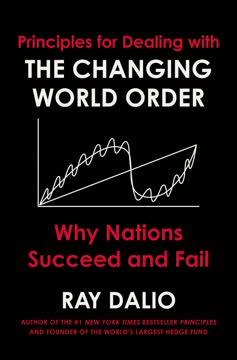Key Takeaways
1. Progressive boards are a competitive advantage, not just compliance enforcers
Make no mistake about it, corporate governance is on the move.
Beyond compliance. Progressive boards go beyond mere compliance with regulations and actively contribute to the company's success. They focus on adding value through strategic insights, rigorous oversight, and fostering a culture of continuous improvement. These boards are characterized by:
- Engaged directors who challenge assumptions and ask probing questions
- A balance between supporting management and maintaining independence
- Regular self-evaluation and commitment to improving board effectiveness
Competitive edge. Companies with Progressive boards gain a significant advantage in today's complex business environment. They benefit from:
- Better decision-making through diverse perspectives and expertise
- Increased adaptability to changing market conditions
- Enhanced credibility with stakeholders, including investors and regulators
2. Group dynamics: The foundation of an effective board
Dialogue is the lifeblood of boards.
Fostering productive interactions. Effective group dynamics are essential for a board to function as a cohesive unit. This involves:
- Establishing clear rules of engagement for board discussions
- Encouraging open and candid dialogue while maintaining respect
- Ensuring all voices are heard and diverse perspectives are considered
Leadership and facilitation. A skilled board leader, whether a lead director or non-executive chair, plays a crucial role in:
-
Guiding discussions to focus on the most critical issues
-
Mediating conflicts and building consensus
-
Maintaining a productive relationship between the board and CEO
-
Executive sessions provide an opportunity for non-executive directors to discuss sensitive issues openly, but must be managed carefully to avoid undermining trust with management.
3. Information architecture: Empowering informed decision-making
Getting the information flow right is a tremendous benefit to management.
Tailored information delivery. An effective information architecture ensures directors receive the right information in the right format at the right time. Key components include:
- Board briefings: Concise reports on current affairs and performance
- Management letters: Regular updates from the CEO between meetings
- Employee surveys: Targeted feedback on specific issues of importance
Beyond financial metrics. Progressive boards look beyond traditional financial reports to gain a holistic view of the company's health:
-
Leading indicators of future performance
-
Qualitative assessments of organizational culture and capabilities
-
External market trends and competitive landscape analysis
-
Director outreach, such as site visits and meetings with employees, provides valuable firsthand insights into company operations and culture.
4. Focus on substantive issues: The board's real work
Asking the right questions is at the very heart of good corporate governance.
Prioritizing critical topics. Boards must focus their limited time on the most important issues facing the company. This involves:
- Developing a Twelve-Month Agenda to ensure coverage of key topics
- Regularly revisiting and updating the agenda as business conditions change
- Balancing short-term performance monitoring with long-term strategic discussions
Asking probing questions. Directors should cultivate the ability to ask incisive questions that uncover potential issues and opportunities:
-
Do we have the right CEO?
-
How well is CEO compensation linked to actual performance?
-
What are the sources of organic growth?
-
Do we have the right approach to diagnosing financial health?
-
Regular strategy immersion sessions allow the board to deeply engage with management on the company's long-term direction and key challenges.
5. CEO selection and succession: The board's most critical responsibility
Nothing else compares.
Continuous process. CEO succession planning should be an ongoing priority, not a reactive measure:
- Regularly assess internal talent and develop a robust leadership pipeline
- Define clear selection criteria based on the company's current and future needs
- Conduct thorough evaluations of both internal and external candidates
Supporting success. The board's role extends beyond selection to ensuring the CEO's success:
-
Provide ongoing feedback and coaching to help the CEO improve
-
Stand behind the CEO during challenging times, while maintaining independence
-
Be prepared to make a change if the CEO is consistently underperforming
-
Emergency succession plans should be in place to address unexpected leadership transitions.
6. CEO compensation: Aligning pay with long-term value creation
Boards must get a handle on CEO compensation once and for all.
Holistic approach. Effective CEO compensation plans balance multiple objectives:
- Short-term and long-term performance metrics
- Financial and non-financial goals
- Individual and company-wide targets
Transparency and accountability. Progressive boards ensure compensation practices are:
-
Clearly linked to the company's strategy and value creation
-
Regularly reviewed and adjusted as needed
-
Communicated transparently to shareholders and other stakeholders
-
Avoid overreliance on a single metric, such as total shareholder return, which can incentivize short-term thinking or excessive risk-taking.
7. Strategy: The board's role in shaping and monitoring direction
The essence of strategy is to describe what direction the business is going in.
Active engagement. While management develops strategy, the board plays a crucial role in:
- Challenging assumptions and asking probing questions
- Ensuring the strategy aligns with the company's capabilities and market realities
- Monitoring execution and adjusting course as needed
Long-term perspective. The board must balance short-term performance pressures with long-term value creation:
-
Regularly assess the company's competitive position and market trends
-
Encourage investments in innovation and capabilities that drive future growth
-
Monitor key milestones and leading indicators of strategic success
-
Strategy blueprints and immersion sessions facilitate deeper board engagement and alignment on strategic direction.
8. Leadership gene pool: Ensuring organizational competence at all levels
Companies that succeed over time are gold mines of leadership talent.
Continuous development. Boards must ensure the company is cultivating a diverse and capable leadership pipeline:
- Regularly review succession plans for key positions beyond the CEO
- Encourage management to provide growth opportunities for high-potential employees
- Monitor diversity and inclusion efforts to build a well-rounded talent pool
Future-focused skills. The leadership gene pool should evolve to meet changing business needs:
-
Anticipate future skill requirements based on industry trends and company strategy
-
Encourage recruitment and development of leaders with diverse experiences and perspectives
-
Regularly assess the effectiveness of leadership development programs
-
Board exposure to rising talent through presentations and site visits provides valuable insights into the depth and quality of the leadership bench.
9. Monitoring health, performance, and risk: Beyond compliance
Properly defined and executed, monitoring is a value-adding activity that taps directors' incisiveness, instincts, and expertise.
Holistic assessment. Progressive boards look beyond traditional financial metrics to gauge company health:
- Financial health: Focus on liquidity and long-term sustainability
- Operating performance: Identify leading indicators of future results
- Risk management: Assess and mitigate potential threats across the business
Forward-looking approach. Effective monitoring involves:
-
Asking "what if" questions to stress-test company plans
-
Encouraging management to develop contingency plans for various scenarios
-
Regularly reassessing the company's risk appetite and tolerance
-
Dedicated risk committees can provide focused oversight of complex risk landscapes in certain industries.
10. Board operations: Streamlining for maximum effectiveness
Common sense and group dynamics should be the guide.
Efficient structures. Optimize board operations to focus on value-adding activities:
- Limit standing committees to essential functions (e.g., Audit, Compensation, Governance)
- Use ad hoc committees for specific issues or projects
- Rotate committee memberships to broaden director experience and perspective
Continuous improvement. Foster a culture of ongoing board development:
-
Conduct regular board evaluations, including individual director assessments
-
Provide continuing education opportunities on relevant topics
-
Carefully consider board composition to ensure diverse skills and experiences
-
Well-designed meeting agendas and pre-read materials maximize productive discussion time during board meetings.
11. Working with investors: Balancing responsiveness and independence
The challenge is to be responsive to external constituencies but not let them replace the collective judgment of the board.
Thoughtful engagement. Boards must navigate complex relationships with diverse investor groups:
- Distinguish between long-term investors and short-term activists
- Develop communication channels to understand and address legitimate concerns
- Maintain independence while being responsive to shareholder feedback
Standing firm when necessary. Boards should:
-
Support management in executing approved strategies, even in the face of short-term pressure
-
Clearly articulate the rationale for major decisions to build credibility
-
Be prepared to make changes when valid concerns are raised
-
Regular communication through annual reports, shareholder letters, and selective direct engagement can build trust and understanding with key investors.
Last updated:
Review Summary
Boards That Deliver receives positive reviews for its practical advice on improving board effectiveness. Readers appreciate Charan's insights on board dynamics, information architecture, and focusing on substantial issues. The book is praised for its clear language, real-life examples, and emphasis on competitiveness over compliance. Some reviewers note the author's shareholder-centric perspective and suggest that board success ultimately depends on having the right people. Overall, the book is recommended for CEOs, board members, and those interested in corporate governance.
Similar Books










Download PDF
Download EPUB
.epub digital book format is ideal for reading ebooks on phones, tablets, and e-readers.









